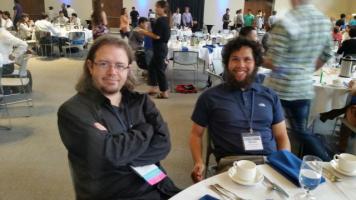News Category:
Clemson, South Carolina, 20040929 (from Dr. Terry Tritt):
Department of Energy awards $3 Million to Clemson
Research focused on “The Next Generation Solid State Power Conversion Materials"
Clemson University, under the guidance of professor Terry M. Tritt in the department of physics and astronomy (P&A), has just received a major grant from the Department of Energy (DOE) to establish a Center of Excellence in Thermoelectric Materials Research. The first phase of the grant (2004-2007) will total almost $3M: $1.32M from DOE and $1.67M from the South Carolina EPSCoR/IDeA Program and Clemson University. The second phase of the grant (2007-2010) is expected to be of similar magnitude. The magnitude of the funds involved in this program will enable Clemson to build a nationally recognized research center focused on the next generation thermoelectric (TE) materials for power conversion and/or refrigeration technologies.
more...
Currently, Tritt is head of Clemson’s Complex and Advanced Materials Laboratory (CAML), considered one of the premier laboratories for thermoelectric materials research in the world. He serves as a consultant to both international and national companies who have an interest in thermoelectric materials development. CAML is also a world-class center for the characterization of electrical and thermal transport (i.e. thermo-physical) properties of materials. This laboratory has been funded primarily by the Departments of Defense (DoD) and DOE.
This DOE grant will enable Clemson to enhance major infrastructure and faculty development in TE power generation materials. With the new faculty hires and major equipment purchases, Tritt foresees Clemson's reputation in this field as being even more enhanced. Other faculty members that are involved in this project include Joseph Kolis (Chemistry), Apparao Rao (P&A), Peter Barnes (Chair, P&A) and Murray Daw (P&A). Prof. Daw was recently elected as a Fellow of the American Academy of Arts and Science and he will lead the computational and modeling efforts of this team. The other faculty will be engaged in the synthesis and characterization of new and novel materials that show potential for use in a breadth of thermoelectric applications. Prof. Rao will lead the efforts in synthesis of nanoscale materials as well as be responsible for spectroscopy characterization of the identified materials. Prof. Kolis will lead the synthesis and elemental characterization efforts of the bulk materials effort. Tritt and Kolis have worked together for over eight years, dating back to when Tritt first returned to Clemson in 1996. Theirs has been a real team effort that has focused on building this research effort step by step over that time period. They were just recently awarded a patent on new materials that they developed on a previous Department of Defense grant.
Novel solid-state materials are currently being investigated by several groups in the United States, with the goal of achieving higher performance TE materials. These materials are being developed for either small-scale refrigeration or power generation applications. Thermoelectric materials and devices are used in cooling CPU computer chips, or conversely, to convert waste heat to generate electrical power for NASA’s deep space probes such as the Voyager and Cassini missions.
At present, TE materials exhibit insufficient efficiency for many broadly related applications and there is a demand to develop the next generation TE materials to yield higher performance devices. TE technologies are important to “energy harvesting†applications to provide electrical power from thermal energy conversion, in which the challenge is to develop new, safe, efficient, environmentally friendly, non-petroleum based sources of power and power generation. Other technologies such as fuel cell batteries or solar power may not be as feasible for many of these applications.
Given the recent power shortages in the US and our dependency on uncertain overseas petroleum fuel supplies, there is an even more pressing need to investigate alternative energy conversion technologies. This includes the thermal to electrical energy conversion from waste heat from natural heat gradients that TE technologies can provide, (even if on a small scale). The incorporation of TE power generation from recovery of the large amount of waste heat (≈ 2/3 of generated power) from an engine exhaust and harvesting this into usable “on-board†electrical energy can provide a reduced demand for fossil fuels and reduce their detrimental impact on the environment. It is not likely that any single technology can solve all, or even a majority, of the national DOE or DoD energy needs of the 21st century or the corresponding civilian energy needs. But in Tritt's opinion, it will be a combination of many different types of technologies, of which, we believe an important one of these will be TE energy conversion.
This DOE grant centers on the investigation of thermal and electrical transport properties of new and novel solid-state systems, with the specific goal of achieving higher efficiency solid-state power generation materials. Along with Tritt and his group of faculty and students, new faculty hires in materials synthesis and neutron scattering and planned major equipment purchases will investigate several classes of materials with potential for TE applications.
Tritt and associates will interact very strongly with the correlated electron group, headed by Dr. David Mandrus, at Oak Ridge National Laboratory (ORNL). ORNL is a premier DOE laboratory located only four hours from Clemson in Oak Ridge, TN. Graduate and undergraduate students and faculty will spend 1-2 months each summer in Oak Ridge collaborating on research with ORNL scientists, who will in turn, conduct research at Clemson. The groups will exchange samples and expertise over the next three years as part of this DOE program. As graduate students are trained in electrical and thermal transport phenomena, ORNL will have access to exceptionally well-trained young scientists as part of their future work force. This aspect will help address a growing national need for trained young scientists in the engineering and sciences disciplines to “stock†our DoD and DOE national laboratories in the years ahead. This grant will support the hiring of new faculty, support two postdoctoral research associates, six graduate students and five undergraduates; all performing world-class research at Clemson.
This grant comes into realization almost 15 months after its inception. Tritt and his fellow faculty members were awarded this DOE project after submitting to an internal proposal competition at Clemson and then a statewide competition including faculty from the University of South Carolina. Two proposals from South Carolina were submitted to DOE in addition to proposals from twenty other EPSCoR states. Tritt's project is one of four funded by DOE this year.
The award of this DOE grant exemplifies both the hard work of Tritt's team of faculty and the South Carolina General Assembly's commitment to supporting research in the state through the SC EPSCoR/IDeA program. State funds provided by the SC EPSCoR/IDeA program will support start-up packages and salary for new faculty at Clemson and will assist in the purchase of major pieces of equipment needed in faculty laboratories. SC EPSCoR/IDeA support will also enable graduate student education through research assistantships and will support undergraduate research during both the summer and academic year periods. In addition, Clemson will also contribute to the start-up packages and salary for new faculty and will aide in the purchase of major pieces of equipment. Clemson will also provide newly renovated space and resources for the growing research team.
-----------------------------------------------------
Developing research in thermoelectric materials and applications helps the universities compete aggressively for highly sought after federal and private research funding. Since 1994, the state’s universities have received more than $44 million from EPSCoR – yielding more than $107 million in related research grants.
Established in 1980, the South Carolina EPSCoR/IDeA (Experimental Program to Stimulate Competitive Research and Institutional Development Awards) Program is the first statewide program to achieve permanent improvements in the state’s research environment, strengthening and enhancing the research infrastructure within academic departments and programs at the state’s three Ph.D. granting universities. In addition to the DOE, EPSCoR has programs within the Environmental Protection Agency, the National Science Foundation, the National Institutes of Health, the National Aeronautics and Space Administration, and the Departments of Defense, Agriculture and Commerce.
The South Carolina General Assembly has recognized the South Carolina EPSCoR Program as a model federal-state-university partnership and has provided approximately $2 million per year to help meet required cost share commitments.




















































































































